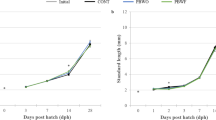Abstract
Probiotics are a live microbial feed supplement that beneficially affects the host animal. As aquaculture is one of the main areas where probiotics can be applied, the environmental suitability of using probiotics in hatching and nursing facilities for turbot farming was evaluated through the life cycle assessment (LCA) methodology. This LCA study showed that the potential environmental impacts associated with probiotic production are generally offset by the impact reductions linked to lower consumption levels and reduced waste and emission generation rates within the hatching and nursing subsystem. Thus, the use of probiotics is recommended in order to enhance the performance of turbot aquaculture systems provided that operational and economic advantages are attained.




Similar content being viewed by others
References
Ayer N, Côté RP, Tyedmers PH, Willison JHM (2009) Sustainability of seafood production and consumption: an introduction to the special issue. J Clean Prod 17:321–324
Balcázar JL, de Blas I, Ruiz-Zarzuela I et al (2006) The role of probiotics in aquaculture. Vet Microbiol 114:173–186
Dimitroglou A, Merrifield DL, Carnevali O et al (2011) Microbial manipulations to improve fish health and production—a Mediterranean perspective. Fish Shellfish Immun 30:1–16
FAO (2010) The state of world fisheries and aquaculture 2010. Food and Agriculture Organization of the United Nations, Italy. ISBN 978-92-5-106675-1
Frischknecht R, Jungbluth N, Althaus HJ et al (2007) Overview and methodology. Ecoinvent report no. 1, v2.0. Swiss Centre for Life Cycle Inventories, Dübendorf
Gatesoupe FJ (1994) Lactic acid bacteria increase the resistance of turbot larvae, Scophthalmus maximus, against pathogenic vibrio. Aquat Living Resour 7:277–282
Gatesoupe FJ (1999) The use of probiotics in aquaculture. Aquaculture 180:147–165
Goedkoop M, de Schryver A, Oele M et al (2010) Introduction to LCA with SimaPro 7. PRé Consultants, The Netherlands
Grönroos J, Seppälä J, Silvenius F, Mäkinen T (2006) Life cycle assessment of Finnish cultivated rainbow trout. Boreal Environ Res 11:401–414
Guinée JB, Gorrée M, Heijungs R et al (2001) Life cycle assessment—an operational guide to the ISO standards. Centre of Environmental Science, Leiden
Hjelm M, Bergh Ø, Riaza A et al (2004) Selection and identification of autochthonous potential probiotic bacteria from turbot larvae (Scophthalmus maximus) rearing units. Syst Appl Microbiol 27:360–371
Huys L, Dhert P, Robles R et al (2001) Search for beneficial bacterial strains for turbot (Scophthalmus maximus L.) larviculture. Aquaculture 193:25–37
Iribarren D (2010) Life cycle assessment of mussel and turbot aquaculture—application and insights. University of Santiago de Compostela, Spain. ISBN 978-84-9887-420-4
Iribarren D, Moreira MT, Feijoo G (2012) Life cycle assessment of aquaculture feed and application to the turbot sector. Int J Environ Res (in press)
ISO (2006a) ISO 14040:2006. Environmental management—life cycle assessment—principles and framework. International Organization for Standardization, Geneva
ISO (2006b) ISO 14044:2006. Environmental management—life cycle assessment—requirements and guidelines. International Organization for Standardization, Geneva
Lozano S, Iribarren D, Moreira MT, Feijoo G (2009) The link between operational efficiency and environmental impacts. A joint application of life cycle assessment and data envelopment analysis. Sci Total Environ 407:1744–1754
Makridis P, Fjellheim AJ, Skjermo J, Vadstein O (2000) Colonization of the gut in first feeding turbot by bacterial strains added to the water or bioencapsulated in rotifers. Aquacult Int 8:367–380
Merrifield DL, Dimitroglou A, Foey A et al (2010) The current status and future focus of probiotic and prebiotic applications for salmonids. Aquaculture 302:1–18
Nayak SK (2010) Probiotics and immunity: a fish perspective. Fish Shellfish Immun 29:2–14
Planas M, Pérez-Lorenzo M, Hjelm M et al (2006) Probiotic effect in vivo of Roseobacter strain 27–4 against Vibrio (Listonella) anguillarum infections in turbot (Scophthalmus maximus L.) larvae. Aquaculture 255:323–333
Varela JL, Ruiz-Jarabo I, Vargas-Chacoff L et al (2010) Dietary administration of probiotic Pdp11 promotes growth and improves stress tolerance to high stocking density in gilthead seabream Sparus auratus. Aquaculture 309:265–271
Verschuere L, Rombaut G, Sorgeloos P, Verstraete W (2000) Probiotic bacteria as biological control agents in aquaculture. Microbiol Mol Biol R 64:655–671
Villamil L, Figueras A, Planas M, Novoa B (2010) Pediococcus acidilactici in the culture of turbot (Psetta maxima) larvae: Administration pathways. Aquaculture 307:83–88
Acknowledgments
This research has been performed under the auspices of the CENIT ACUISOST project.
Author information
Authors and Affiliations
Corresponding author
Rights and permissions
About this article
Cite this article
Iribarren, D., Dagá, P., Moreira, M.T. et al. Potential environmental effects of probiotics used in aquaculture. Aquacult Int 20, 779–789 (2012). https://doi.org/10.1007/s10499-012-9502-z
Received:
Accepted:
Published:
Issue Date:
DOI: https://doi.org/10.1007/s10499-012-9502-z




